History of water supply and sanitation: Difference between revisions
WP:CHECKWIKI error fix #90. Wikipedia being used as a reference or external link. Do general fixes and cleanup if needed. - using AWB (11971) |
→Modern age: copied content from Combined_sewer#History; see that page's history for attribution. Purpose: to expand this page and to slim down the other one. |
||
| Line 74: | Line 74: | ||
As cities grew in the 19th century, increasing concerns were raised about [[public health]].<ref name="Burian">{{cite journal|last=Burian|first=Steven J.|last2=Nix|first2=Stephan J.|last3=Pitt|first3=Robert E.|last4=Durrans|first4=S. Rocky|year=2000|title=Urban Wastewater Management in the United States: Past, Present, and Future|url=http://www.sewerhistory.org/articles/whregion/urban_wwm_mgmt/urban_wwm_mgmt.pdf|journal=Journal of Urban Technology|location=London|publisher=Routledge|volume=7|issue=3|doi=10.1080/713684134}}</ref>{{rp|33–62}} As part of a trend of municipal [[sanitation]] programs in the late 19th and 20th centuries, many cities constructed extensive sewer systems to help control outbreaks of [[disease]] such as [[typhoid]] and [[cholera]].<ref name="Staley1899">{{cite book|url=http://books.google.com/books?id=jT81AAAAMAAJ|title=The Separate System of Sewerage, Its Theory and Construction|last2=Pierson|first2=George S.|publisher=Van Nostrand|year=1899|isbn=|location=New York|page=|pages=|last1=Staley|first1=Cady|authorlink=|accessdate=}}</ref>{{Rp|29–34|date=May 2009}} |
As cities grew in the 19th century, increasing concerns were raised about [[public health]].<ref name="Burian">{{cite journal|last=Burian|first=Steven J.|last2=Nix|first2=Stephan J.|last3=Pitt|first3=Robert E.|last4=Durrans|first4=S. Rocky|year=2000|title=Urban Wastewater Management in the United States: Past, Present, and Future|url=http://www.sewerhistory.org/articles/whregion/urban_wwm_mgmt/urban_wwm_mgmt.pdf|journal=Journal of Urban Technology|location=London|publisher=Routledge|volume=7|issue=3|doi=10.1080/713684134}}</ref>{{rp|33–62}} As part of a trend of municipal [[sanitation]] programs in the late 19th and 20th centuries, many cities constructed extensive sewer systems to help control outbreaks of [[disease]] such as [[typhoid]] and [[cholera]].<ref name="Staley1899">{{cite book|url=http://books.google.com/books?id=jT81AAAAMAAJ|title=The Separate System of Sewerage, Its Theory and Construction|last2=Pierson|first2=George S.|publisher=Van Nostrand|year=1899|isbn=|location=New York|page=|pages=|last1=Staley|first1=Cady|authorlink=|accessdate=}}</ref>{{Rp|29–34|date=May 2009}} |
||
As Britain was the first country to industrialize, it was also the first to experience the disastrous consequences of major [[urbanisation]] and was the first to construct a modern sewerage system to mitigate the resultant unsanitary conditions.{{Citation needed|date=December 2013}} During the early 19th century, the [[River Thames]] was effectively an open sewer, leading to frequent outbreaks of [[cholera]] epidemics. Proposals to modernise the sewerage system had been made during 1856, but were neglected due to lack of funds. However, after the ''[[Great Stink]]'' of 1858, [[Parliament of the United Kingdom|Parliament]] realised the urgency of the problem and resolved to create a modern sewerage system. |
From as early as 1535 there were efforts to stop polluting the Thames. Beginning with an Act passed that year that was to prohibit the dumping of excrement into the river. Leading up to the Industrial Revolution the River Thames was identified as being thick and black due to sewage, and it was even said that the river “smells like death.”<sup>[[Combined sewer|[31]]]</sup> As Britain was the first country to industrialize, it was also the first to experience the disastrous consequences of major [[urbanisation]] and was the first to construct a modern sewerage system to mitigate the resultant unsanitary conditions.{{Citation needed|date=December 2013}} During the early 19th century, the [[River Thames]] was effectively an open sewer, leading to frequent outbreaks of [[cholera]] epidemics. Proposals to modernise the sewerage system had been made during 1856, but were neglected due to lack of funds. However, after the ''[[Great Stink]]'' of 1858, [[Parliament of the United Kingdom|Parliament]] realised the urgency of the problem and resolved to create a modern sewerage system. |
||
[[Joseph Bazalgette]], a [[civil engineer]] and Chief Engineer of the [[Metropolitan Board of Works]], was given responsibility for the work. He designed an extensive underground sewerage system that diverted waste to the [[Thames Estuary]], downstream of the main centre of population. Six main interceptor sewers, totalling almost 100 miles (160 km) in length, were constructed, some incorporating stretches of [[Subterranean rivers of London|London's 'lost' rivers]]. Three of these sewers were north of the river, the southernmost, low-level one being incorporated in the [[Thames Embankment]]. The Embankment also allowed new roads, new public gardens, and the [[Circle line (London Underground)|Circle Line]] of the [[London Underground]]. |
[[Joseph Bazalgette]], a [[civil engineer]] and Chief Engineer of the [[Metropolitan Board of Works]], was given responsibility for the work. He designed an extensive underground sewerage system that diverted waste to the [[Thames Estuary]], downstream of the main centre of population. Six main interceptor sewers, totalling almost 100 miles (160 km) in length, were constructed, some incorporating stretches of [[Subterranean rivers of London|London's 'lost' rivers]]. Three of these sewers were north of the river, the southernmost, low-level one being incorporated in the [[Thames Embankment]]. The Embankment also allowed new roads, new public gardens, and the [[Circle line (London Underground)|Circle Line]] of the [[London Underground]]. |
||
Revision as of 07:46, 18 April 2016

Water supply and sanitation has been a primary logistical challenge since the dawn of civilization. Where water resources or infrastructure or sanitation systems are insufficient for the population, people fall prey to disease, dehydration, and in extreme cases, death.
Major human settlements could initially develop only where fresh surface water was plentiful, such as near major rivers. Over the millennia, technology has dramatically increased the distances across which water can be relocated, but the availability of clean and fresh water remains a limiting factor on the size and density of population centers, and is expected to remain so into the foreseeable future.
Prehistory

During the Neolithic, humans dug the first permanent water wells, from where vessels could be filled and carried by hand. Wells dug around 6500 BC have been found in the Jezreel Valley.[1] Stepwells have mainly been used in Indian subcontinent. The size of human settlements was largely dependent on nearby available water.
Pit latrines and chamber pots were the only alternative to open defecation.
Devices such as shadoofs, and sakias were used to lift water to ground level. Mohenjo-daro ruins in Pakistan, Dholavira in Kutch district of Gujarat, part of the Indus Valley Civilization, shows that the settlements had one of the ancient world's most sophisticated sewage system that contained drainage channels, rain water harvesting and street ducts.[2]
Ancient age
Throughout history people have devised systems to make getting water into their communities and households, and disposing (and later also treating) wastewater more convenient.[3]
The historical focus of sewage treatment was on the conveyance of raw sewage to a natural body of water, e.g. a river or ocean, where it would be satisfactorily diluted and dissipated. Early human habitations were often built next to water sources. Rivers would often double as a crude form of natural sewage disposal.
The first sanitation systems were built in the prehistoric Middle East, in the south-east of the modern country of Iran near Zabol. An inverted siphon system, along with glass covered clay pipes, was used for the first time in the palaces of Crete, Greece. It is still in working condition, after about 3000 years.[citation needed]
Roman towns and garrisons in the United Kingdom between 46 BC and 400 AD had complex sewer networks sometimes constructed out of hollowed-out elm logs, which were shaped so that they butted together with the down-stream pipe providing a socket for the upstream pipe.[citation needed]
Indus Valley Civilization
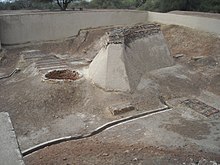
The Indus Valley Civilization in Asia shows early evidence of public water supply and sanitation. The system the Indus developed and managed included a number of advanced features. A typical example is the Indus city of Lothal. In this Indus city, all houses had their own private toilet, connected to a covered sewer network constructed of brickwork held together with a gypsum-based mortar that emptied either into the surrounding water bodies or alternatively into cesspits, the latter of which were regularly emptied and cleaned.[4][5]
The urban areas of the Indus Valley civilization provided public and private baths, sewage was disposed through underground drains built with precisely laid bricks, and a sophisticated water management system with numerous reservoirs was established. In the drainage systems, drains from houses were connected to wider public drains.[6]
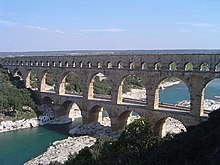
Ancient Greek civilization
The ancient Greek civilization of Crete, known as the Minoan civilization, was the first civilization to use underground clay pipes for sanitation and water supply.[7] Their capital, Knossos, had a well-organized water system for bringing in clean water, taking out waste water and storm sewage canals for overflow when there was heavy rain. It was also one of the first uses of a flush toilet, dating back to 18th century BC.[8] The Minoan civilization had stone sewers that were periodically flushed with clean water.[citation needed] In addition to sophisticated water and sewer systems they devised elaborate heating systems. The Ancient Greeks of Athens and Asia Minor also used an indoor plumbing system, used for pressurized showers.[9] The Greek inventor Heron used pressurized piping for fire fighting purposes in the City of Alexandria.[10] The Mayans were the third earliest civilization to have employed a system of indoor plumbing using pressurized water.
Roman Empire
The Roman Empire had indoor plumbing, meaning a system of aqueducts and pipes that terminated in homes and at public wells and fountains for people to use. Rome and other nations used lead pipes; while commonly thought to be the cause of lead poisoning in the Roman Empire, the combination of running water which did not stay in contact with the pipe for long and the deposition of precipitation scale actually mitigated the risk from lead pipes.[11][12]
Others
Persian Qanats and ab anbars have been used for water supply and cooling in the Middle East.
Plumbing is also known to have been used in East Asia since the Qin and Han Dynasties. [13]
Middle and early modern age
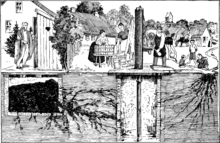

Pail closets, outhouses, and cesspits were used to collect human waste. The use of human waste as fertilizer was especially important in China and Japan, where cattle manure was less available. However, most cities did not have a functioning sewer system before the Industrial era, relying instead on nearby rivers or occasional rain showers to wash away the sewage from the streets. In some places, waste water simply ran down the streets, which had stepping stones to keep pedestrians out of the muck, and eventually drained as runoff into the local watershed.
In the 16th century, Sir John Harington invented a flush toilet as a device for Queen Elizabeth I (his godmother) that released wastes into cesspools.[citation needed]
After the adoption of gunpowder, municipal outhouses became an important source of raw material for the making of saltpeter in European countries.[14]
In London, the contents of the city's outhouses were collected every night by commissioned wagons and delivered to the nitrite beds where it was sown into the special soil beds to produce earth rich in mineral nitrates. The nitrate rich-earth is then further processed to produce saltpeter, or potassium nitrate, an important ingredient in black powder.[15]
Classic and Early Modern Mesoamerica
The Classic Maya at Palenque had underground aqueducts and flush toilets; the Classic Maya even used household water filters using locally abundant limestone carved into a porous cylinder, made so as to work in a manner strikingly similar to Modern ceramic water filters.[16][17]
Modern age
Sewer systems
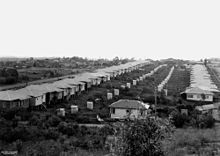
A significant development was the construction of a network of sewers to collect waste water. In some cities, including Rome, Istanbul (Constantinople) and Fustat, networked ancient sewer systems continue to function today as collection systems for those cities' modernized sewer systems. Instead of flowing to a river or the sea, the pipes have been re-routed to modern sewer treatment facilities.
However, until the Enlightenment era, little progress was made in water supply and sanitation and the engineering skills of the Romans were largely neglected throughout Europe. This began to change in the 17th and 18th centuries with a rapid expansion in waterworks and pumping systems.
The tremendous growth of cities during the Industrial Revolution quickly led to terribly overpolluted streets, which acted as a constant source for the outbreak of disease. As recently as the late 19th century sewerage systems in some parts of the highly industrialised United Kingdom were so inadequate that water-borne diseases such as cholera and typhoid remained a risk. In Merthyr Tydfil, a large town in South Wales, most houses discharged their sewage to individual cess-pits which persistently overflowed causing the pavements to be awash with foul sewage.[18]
As cities grew in the 19th century, increasing concerns were raised about public health.[19]: 33–62 As part of a trend of municipal sanitation programs in the late 19th and 20th centuries, many cities constructed extensive sewer systems to help control outbreaks of disease such as typhoid and cholera.[20]: 29–34
From as early as 1535 there were efforts to stop polluting the Thames. Beginning with an Act passed that year that was to prohibit the dumping of excrement into the river. Leading up to the Industrial Revolution the River Thames was identified as being thick and black due to sewage, and it was even said that the river “smells like death.”[31] As Britain was the first country to industrialize, it was also the first to experience the disastrous consequences of major urbanisation and was the first to construct a modern sewerage system to mitigate the resultant unsanitary conditions.[citation needed] During the early 19th century, the River Thames was effectively an open sewer, leading to frequent outbreaks of cholera epidemics. Proposals to modernise the sewerage system had been made during 1856, but were neglected due to lack of funds. However, after the Great Stink of 1858, Parliament realised the urgency of the problem and resolved to create a modern sewerage system.
Joseph Bazalgette, a civil engineer and Chief Engineer of the Metropolitan Board of Works, was given responsibility for the work. He designed an extensive underground sewerage system that diverted waste to the Thames Estuary, downstream of the main centre of population. Six main interceptor sewers, totalling almost 100 miles (160 km) in length, were constructed, some incorporating stretches of London's 'lost' rivers. Three of these sewers were north of the river, the southernmost, low-level one being incorporated in the Thames Embankment. The Embankment also allowed new roads, new public gardens, and the Circle Line of the London Underground.
The intercepting sewers, constructed between 1859 and 1865, were fed by 450 miles (720 km) of main sewers that, in turn, conveyed the contents of some 13,000 miles (21,000 km) of smaller local sewers. Construction of the interceptor system required 318 million bricks, 2.7 million cubic metres of excavated earth and 670,000 cubic metres of concrete.[21] Gravity allowed the sewage to flow eastwards, but in places such as Chelsea, Deptford and Abbey Mills, pumping stations were built to raise the water and provide sufficient flow. Sewers north of the Thames feed into the Northern Outfall Sewer, which fed into a major treatment works at Beckton. South of the river, the Southern Outfall Sewer extended to a similar facility at Crossness. With only minor modifications, Bazalgette's engineering achievement remains the basis for sewerage design up into the present day.[22]
The first comprehensive sewer system was built in Hamburg, Germany in the mid-19th century.[23]: 43 [24]: 2 The first such systems in the United States were built in the late 1850s in Chicago and Brooklyn.[23]: 43
Another significant engineer of the period was William Lindley, who, in 1863, began work on the construction of a modern sewerage system for the rapidly growing city of Frankfurt am Main. 20 years after the system's completion, the death rate from typhoid had fallen from 80 to 10 per 100,000 inhabitants.[23]: 43 [24][25]
Initially these systems discharged sewage directly to surface waters without treatment. Later, cities attempted to treat the sewage before discharge in order to prevent water pollution and waterborne diseases.
Early techniques involved land application of sewage on agricultural land. In the late 19th century some cities began to add chemical treatment and sedimentation systems to their sewers.[24]: 28 In the United States, the first sewage treatment plant using chemical precipitation was built in Worcester, Massachusetts in 1890.[24]: 29 Most cities in the Western world added more expensive systems for sewage treatment in the early 20th century, after scientists at the University of Manchester discovered the sewage treatment process of activated sludge in 1912.[26] During the half-century around 1900, these public health interventions succeeded in drastically reducing the incidence of water-borne diseases among the urban population, and were an important cause in the increases of life expectancy experienced at the time.[27]
Toilets
With the onset of the industrial revolution and related advances in technology, the flush toilet began to emerge into its modern form. It needs to be connected to a sewer system though. Where this is not feasible or desired, dry toilets are an alternative option.
Water supply

An ambitious engineering project to bring fresh water from Hertfordshire to London was undertaken by Hugh Myddleton who oversaw the construction of the New River between 1609 and 1613. The New River Company became one of the largest private water companies of the time, supplying the City of London and other central areas.[28]
It was in the 18th century that a rapidly growing population fueled a boom in the establishment of private water supply networks in London. The Chelsea Waterworks Company was established in 1723 "for the better supplying the City and Liberties of Westminster and parts adjacent with water".[29][30] The company created extensive ponds in the area bordering Chelsea and Pimlico using water from the tidal Thames. Other waterworks were established in London, including at West Ham in 1743, at Lea Bridge before 1767, Lambeth Waterworks Company in 1785, West Middlesex Waterworks Company in 1806[31] and Grand Junction Waterworks Company in 1811.[32]
The S-bend pipe was invented by Alexander Cummings in 1775 but became known as the U-bend following the introduction of the U-shaped trap by Thomas Crapper in 1880. The first screw-down water tap was patented in 1845 by Guest and Chrimes, a brass foundry in Rotherham.[33]
Water treatment
At the same time, the first experiments into water filtration were made. Sir Francis Bacon attempted to desalinate sea water by passing the flow through a sand filter. Although his experiment didn't succeed, it marked the beginning of a new interest in the field. Fathers of microscopy, Antonie van Leeuwenhoek and Robert Hooke, used the newly invented microscope to observe for the first time small material particles that lay suspended in the water, laying the groundwork for the future understanding of waterborne pathogens.[34]
As pollution of water bodies became a concern, cities attempted to treat the sewage before discharge. Early techniques involved land application of sewage on agricultural land. In the late 19th century some cities began to add chemical treatment and sedimentation systems to their sewers.[24]: 28 In the United States, the first sewage treatment plant using chemical precipitation was built in Worcester, Massachusetts in 1890.[24]: 29 Most cities in the Western world added more expensive systems for sewage treatment in the early 20th century, after scientists at the University of Manchester discovered the sewage treatment process of activated sludge in 1912.[26] During the half-century around 1900, these public health interventions succeeded in drastically reducing the incidence of water-borne diseases among the urban population, and were an important cause in the increases of life expectancy experienced at the time.[27]
Sand filter
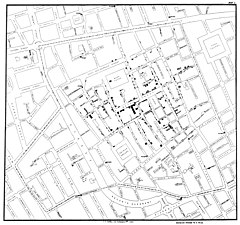
The first documented use of sand filters to purify the water supply dates to 1804, when the owner of a bleachery in Paisley, Scotland, John Gibb, installed an experimental filter, selling his unwanted surplus to the public.[35][36] This method was refined in the following two decades by engineers working for private water companies, and it culminated in the first treated public water supply in the world, installed by engineer James Simpson for the Chelsea Waterworks Company in London in 1829.[37][38] This installation provided filtered water for every resident of the area, and the network design was widely copied throughout the United Kingdom in the ensuing decades.
The practice of water treatment soon became mainstream, and the virtues of the system were made starkly apparent after the investigations of the physician John Snow during the 1854 Broad Street cholera outbreak. Snow was sceptical of the then-dominant miasma theory that stated that diseases were caused by noxious "bad airs". Although the germ theory of disease had not yet been developed, Snow's observations led him to discount the prevailing theory. His 1855 essay On the Mode of Communication of Cholera conclusively demonstrated the role of the water supply in spreading the cholera epidemic in Soho,[39] with the use of a dot distribution map and statistical proof to illustrate the connection between the quality of the water source and cholera cases. His data convinced the local council to disable the water pump, which promptly ended the outbreak.
The Metropolis Water Act introduced the regulation of the water supply companies in London, including minimum standards of water quality for the first time. The Act "made provision for securing the supply to the Metropolis of pure and wholesome water", and required that all water be "effectually filtered" from 31 December 1855.[40] This was followed up with legislation for the mandatory inspection of water quality, including comprehensive chemical analyses, in 1858. This legislation set a worldwide precedent for similar state public health interventions across Europe. The Metropolitan Commission of Sewers was formed at the same time, water filtration was adopted throughout the country, and new water intakes on the Thames were established above Teddington Lock. Automatic pressure filters, where the water is forced under pressure through the filtration system, were innovated in 1899 in England.[35]
Water chlorination
In what may have been one of the first attempts to use chlorine, William Soper used chlorinated lime to treat the sewage produced by typhoid patients in 1879.
In a paper published in 1894, Moritz Traube formally proposed the addition of chloride of lime (calcium hypochlorite) to water to render it "germ-free." Two other investigators confirmed Traube’s findings and published their papers in 1895.[41] Early attempts at implementing water chlorination at a water treatment plant were made in 1893 in Hamburg, Germany and in 1897 the city of Maidstone England was the first to have its entire water supply treated with chlorine.[42]
Permanent water chlorination began in 1905, when a faulty slow sand filter and a contaminated water supply led to a serious typhoid fever epidemic in Lincoln, England.[43] Dr. Alexander Cruickshank Houston used chlorination of the water to stem the epidemic. His installation fed a concentrated solution of chloride of lime to the water being treated. The chlorination of the water supply helped stop the epidemic and as a precaution, the chlorination was continued until 1911 when a new water supply was instituted.[44]

The first continuous use of chlorine in the United States for disinfection took place in 1908 at Boonton Reservoir (on the Rockaway River), which served as the supply for Jersey City, New Jersey.[45] Chlorination was achieved by controlled additions of dilute solutions of chloride of lime (calcium hypochlorite) at doses of 0.2 to 0.35 ppm. The treatment process was conceived by Dr. John L. Leal and the chlorination plant was designed by George Warren Fuller.[46] Over the next few years, chlorine disinfection using chloride of lime were rapidly installed in drinking water systems around the world.[47]
The technique of purification of drinking water by use of compressed liquefied chlorine gas was developed by a British officer in the Indian Medical Service, Vincent B. Nesfield, in 1903. According to his own account, "It occurred to me that chlorine gas might be found satisfactory ... if suitable means could be found for using it.... The next important question was how to render the gas portable. This might be accomplished in two ways: By liquefying it, and storing it in lead-lined iron vessels, having a jet with a very fine capillary canal, and fitted with a tap or a screw cap. The tap is turned on, and the cylinder placed in the amount of water required. The chlorine bubbles out, and in ten to fifteen minutes the water is absolutely safe. This method would be of use on a large scale, as for service water carts."[48]
U.S. Army Major Carl Rogers Darnall, Professor of Chemistry at the Army Medical School, gave the first practical demonstration of this in 1910. Shortly thereafter, Major William J. L. Lyster of the Army Medical Department used a solution of calcium hypochlorite in a linen bag to treat water. For many decades, Lyster's method remained the standard for U.S. ground forces in the field and in camps, implemented in the form of the familiar Lyster Bag (also spelled Lister Bag). This work became the basis for present day systems of municipal water purification.
Fluoridation
Water fluoridation has been carried out since the early 20th century, to decrease tooth decay. The practice remains controversial, though.
Today (21st century and beyond)
Decentralization of water infrastructure has grown extensively as a viable solution including rainwater harvesting and stormwater harvesting where policies are eventually tending towards a more rational use and sourcing of water incorporation concepts such as "Fit for Purpose".
The Sustainable Development Goals formulated in 2015 include targets on access to water supply and sanitation at a global level.
During the beginning of the 21st century, especially in areas of urban and suburban population centres, traditional centralized infrastructure have not been able to supply sufficient quantities of water to keep up with growing demand. One option is the use of desalination technology, this is especially prevalent in coastal areas and in "dry" countries like Australia.
See also
References
- ^ Ashkenazi, Eli (Nov 9, 2012). "Ancient well reveals secrets of first Jezreel Valley farmers". haaretz.com. Haaretz. Retrieved 26 March 2014.
- ^ Mughal, Muhammad Aurang Zeb. 2011. Mohenjo-daro’s Sewers. In Kevin Murray McGeough (ed.), World History Encyclopedia, Vol. 3. Santa Barbara, CA: ABC-CLIO, pp. 121-122.
- ^ "The Art of Plumbing as Recorded through History". www.academia.edu. Retrieved 2016-03-10.
- ^ Khan, Saifullah. "1 Chapter 2 Sanitation and wastewater technologies in Harappa/Indus valley civilization ( ca . 2600-1900 BC)". Academia.edu. Academia.edu. Retrieved 9 April 2015.
{{cite web}}: External link in|ref= - ^ "Maya plumbing: First pressurized water feature found in New World". Penn State. May 5, 2010. Retrieved 26 March 2014.
- ^ Rodda, J. C. and Ubertini, Lucio (2004). The Basis of Civilization - Water Science? pg 161. International Association of Hydrological Sciences (International Association of Hydrological Sciences Press 2004).
- ^ "The History of Plumbing - CRETE". theplumber.com. theplumber.com. Retrieved 26 March 2014.
- ^ "Fieldnotes". themodernantiquarian.com. Retrieved 26 March 2014.
- ^ "Ancient Inventions Showers". inventions.org. inventions.org. Archived from the original on May 9, 2008. Retrieved 26 March 2014.
{{cite web}}: Unknown parameter|deadurl=ignored (|url-status=suggested) (help) - ^ Jaffe, Eric. "Old World, High Tech". smithsonianmag.com. Smithsonian Magazine. Retrieved 26 March 2014.
- ^ "Lead Poisoning and Rome". Retrieved 4 June 2013.
- ^ Hodge 1992, p. 308
- ^ Chavalas, Mark. "Great Events from History: The Ancient World, Prehistory-476 C.E."
- ^ Firearms: A Global History to 1700, Kenneth Chase
- ^ Instructions for the Manufacture of Saltpetre, Joseph LeConte, 1823-1901
- ^ Environmental and Water Resources Milestones in Engineering History. Tampa, Florida, USA: ASCE Publications. March 15–19, 2007.
- ^ "Maya plumbing: First pressurized water feature found in New World". Science Daily. Retrieved 6 March 2014.
- ^ Report of the Principal Officer of Health, Glamorgan County Council, 1889
- ^ Burian, Steven J.; Nix, Stephan J.; Pitt, Robert E.; Durrans, S. Rocky (2000). "Urban Wastewater Management in the United States: Past, Present, and Future" (PDF). Journal of Urban Technology. 7 (3). London: Routledge. doi:10.1080/713684134.
- ^ Staley, Cady; Pierson, George S. (1899). The Separate System of Sewerage, Its Theory and Construction. New York: Van Nostrand.
- ^ Goodman, David C.; Chant, Colin (1999). European Cities and Technology. London: Routledge. ISBN 9780415200790.
- ^ Kendall F. Haven (2006). 100 Greatest Science Inventions of All Time. Libraries Unlimited. pp. 148–149.
- ^ a b c Burian, Steven J.; Nix, Stephan J.; Pitt, Robert E.; Durrans, S. Rocky (2000). "Urban Wastewater Management in the United States: Past, Present, and Future" (PDF). Journal of Urban Technology. 7 (3). London: Routledge. doi:10.1080/713684134.
- ^ a b c d e f Metcalf, Leonard; Eddy, Harrison P. (1914). American Sewerage Practice. New York: McGraw-Hill. Vol. I: Design of Sewers.
- ^ Lee, Sidney, ed. (1901). . Dictionary of National Biography (1st supplement). London: Smith, Elder & Co.
- ^ a b Benidickson, Jamie (2011). The Culture of Flushing: A Social and Legal History of Sewage. UBC Press. Retrieved 2013-02-07.
- ^ a b Cutler, David; Miller, Grant (May 2004). "The Role of Public Health Improvements in Health Advances: The 20th Century United States". National Bureau of Economic Research, Cambridge, MA. NBER Working Paper No. 10511.
- ^ "Water-related Infrastructure in Medieval London". waterhistory.org. Retrieved 2007-03-24.
- ^ The London Encyclopaedia, Ben Weinreb & Christopher Hibbert, Macmillan, 1995, ISBN 0-333-57688-8
- ^ Royal Charters, Privy Council website
- ^ UCLA Department of Epidemiology West Middlesex Waterworks history
- ^ UCLA Department of Epidemiology Lambeth Waterwork history
- ^ "A Little About Tap History". Retrieved 2012-12-17.
- ^ "The Use of the Microscope in Water Filter History". Retrieved 2012-12-17.
- ^ a b Filtration of water supplies (PDF), World Health Organization
- ^ Buchan, James. (2003). Crowded with genius: the Scottish enlightenment: Edinburgh's moment of the mind. New York: Harper Collins.
- ^ History of the Chelsea Waterworks
- ^ Christman, Keith. (1998). The history of chlorine. Waterworld, 14 (8), 66-67.
- ^ Concepts and practice of humanitarian medicine (2008) Par S. William Gunn, M. Masellis ISBN 0-387-72263-7 [1]
- ^ An Act to make better Provision respecting the Supply of Water to the Metropolis, (15 & 16 Vict. C.84)
- ^ Turneaure, F.E., and H.L. Russell (1901). Public Water-Supplies: Requirements, Resources, and the Construction of Works (1st ed.). New York: John Wiley & Sons. p. 493.
{{cite book}}: CS1 maint: multiple names: authors list (link) - ^ "Typhoid Epidemic at Maidstone". Journal of the Sanitary Institute. 18: 388. October 1897.
- ^ "A miracle for public health?". Retrieved 2012-12-17.
- ^ Reece, R.J. (1907). "Report on the Epidemic of Enteric Fever in the City of Lincoln, 1904-5." In Thirty-Fifth Annual Report of the Local Government Board, 1905-6: Supplement Containing the Report of the Medical Officer for 1905-6. London:Local Government Board.
- ^ Leal, John L. (1909). "The Sterilization Plant of the Jersey City Water Supply Company at Boonton, N.J." Proceedings American Water Works Association. pp. 100-9.
- ^ Fuller, George W. (1909). "Description of the Process and Plant of the Jersey City Water Supply Company for the Sterilization of the Water of the Boonton Reservoir." Proceedings AWWA. pp. 110-34.
- ^ Hazen, Allen. (1916). Clean Water and How to Get It. New York:Wiley. p. 102.
- ^ V. B. Nesfield (1902). "A Chemical Method of Sterilizing Water Without Affecting its Potability". Public Health: 601–3.
Further reading
- Blake, Nelson M. Water for the Cities: A History of the Urban Water Supply Problem in the US (1956).
- Cain, Louis P. Sanitation Strategy for a Lakefront Metropolis: The Case of Chicago (1978)
- Cain, Louis P. "Sanitation in Chicago: A Strategy for a Lakefront Metropolis," Encyclopedia of Chicago (2004) online
- Galishoff, Stuart. Newark: the nation's unhealthiest city, 1832-1895 (1988). in USA
- Hammer, Mark J., and Paul A. Chadik. Water supply and pollution control (Pearson Prentice Hall, 2009)
- Juuti, Petri S., Tapio S. Katko, and Heikki S. Vuorinen. Environmental history of water: global views on community water supply and sanitation (IWA Publishing, 2007)
- Teresi, Dick; et al. (2002). Lost Discoveries: The Ancient Roots of Modern Science--from the Babylonians to the Maya. New York: Simon & Schuster. p. 352. ISBN 0-684-83718-8.
- Weidner, Charles H. Water for a city: A history of New York City's problem from the beginning to the Delaware River system (Rutgers University Press, 1974)
